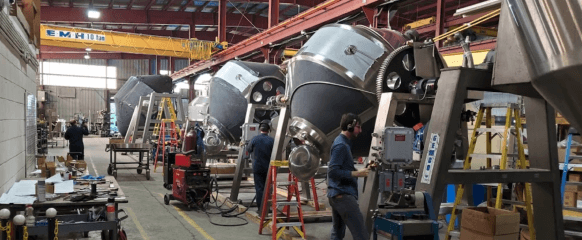Mixing & Drying: Dry Bakery Industry
The dry bakery industry relies on a variety of powdered ingredients to create the delicious and visually appealing baked goods we all know and love. But before these starches and additives reach their final destination, they often require meticulous processing to ensure consistent quality.
This blog post explores the challenges faced by manufacturers in the dry bakery industry when it comes to mixing and drying, and the solutions offered by GEMCO and its affiliate company, Advanced Powder Solutions (APS).

The Power of Tumble Mixing and Drying
Mixing and drying are essential steps for converting raw materials into a usable, consistent dry product. Powders like tapioca starch, often produced through spray drying, can suffer from inconsistencies in color, texture, and flowability. This is where GEMCO and APS come in. Their expertise lies in de-lumping, smoothing, and achieving uniformity in these dry ingredients.
The experience with a customer from the Dry Bakery industry illustrates this perfectly. They produced spray-dried tapioca powder that lacked uniformity in color and texture. Traditional equipment, including ribbon blenders and rotary dryers that they used, proved ineffective due to extended processing times, dead spots, and outdated technology. In pursuit of addressing their operational challenges, the company engaged APS to conduct testing and implement solutions leveraging GEMCO’s advanced technology.
GEMCO and APS’s approach revolutionized their process. They were able to provide a solution that addressed the specific challenges of the application. This emphasizes a major advantage: their comprehensive understanding of the complexities involved in blending and dehydrating dry bakery ingredients.

Reducing Waste and Optimizing Costs
What sets GEMCO and APS apart is their capacity to assist manufacturers in reworking these powders, reducing waste and rejection rates, and resulting in substantial cost savings.
The dry bakery industry is more competitive than anticipated, but GEMCO and APS stand tall. Their unwavering commitment to cutting-edge technology and in-depth knowledge position them as the perfect partner for manufacturers seeking to optimize their mixing and drying processes.
While spray drying offers a high-volume approach to powder production, it can leave inconsistencies in color, texture, and flowability. In this case, the customer’s tapioca powder suffered from these very issues. They produce a variety of powders, including different excipients such as filler powders and powdered materials for various industries, including food products. In this case, the spray-dried tapioca powder was not uniform – there were variations in color and texture. Although it was flowable, it was not consistent. Most spray-dried powders, despite the consistency of previous machinery used, can still require additional conditioning and drying. Spray drying is commonly used to produce large quantities of powder. It begins with an emulsion containing 20-30% solids and can consist of one or more components. The material is pumped through a nozzle and sprayed into a preheated vessel. The resulting powder can vary in color, consistency, and flow characteristics. Some batches may require additional conditioning and drying.
GEMCO and APS’s technology addressed these inconsistencies through a meticulous process. Traditional methods, like ribbon blenders with long processing times and potential dead spots, were not suitable. Instead, GEMCO and APS likely employed a more advanced method that promotes better particle distribution and eliminates stagnant zones. This material is sticky and not uniform. We had to dry it at temperatures not exceeding 150 to 170 degrees Fahrenheit to preserve the integrity of the tapioca starch. The result? A de-lumped, smooth, and uniform dry product that met strict quality requirements for food-grade tapioca powder.
Conclusion
Inconsistent raw material quality and the high costs associated with inefficient processing and rework are significant hurdles across the dry bakery industry. The future, however, is brimming with exciting possibilities. The constant influx of new and diverse products demands innovative solutions from mixing and drying equipment manufacturers. GEMCO and APS are well-positioned to address this challenge, as evidenced by their superior technology and consistent outperformance against competitors.
This blog post merely scratches the surface of GEMCO and APS’s capabilities. If you’re a manufacturer in the dry bakery industry facing challenges with your powdered ingredients, don’t hesitate to reach out to GEMCO and APS. They’re here to help you achieve consistent quality and unlock the full potential of your products.


